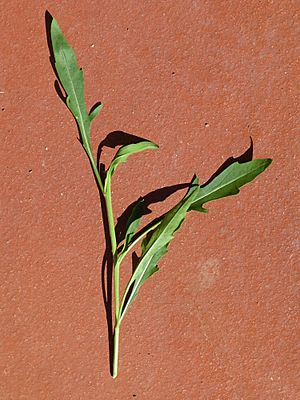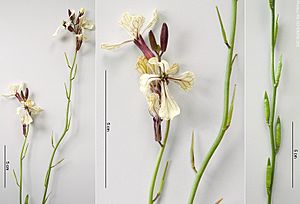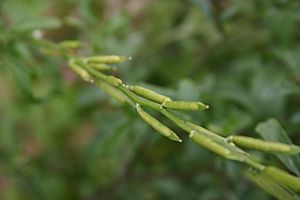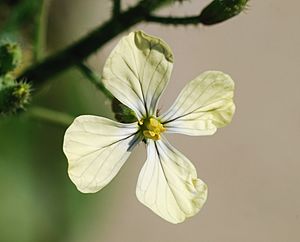Eruca vesicaria facts for kids
Quick facts for kids Eruca vesicaria |
|
|---|---|
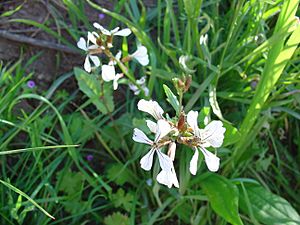 |
|
| Scientific classification | |
| Genus: |
Eruca
|
| Species: |
vesicaria
|
Rocket or arugula (American English) (Eruca vesicaria; syns. Eruca sativa Mill., E. vesicaria subsp. sativa (Miller) Thell., Brassica eruca L.) is an edible annual plant in the family Brassicaceae used as a leaf vegetable for its fresh, tart, bitter, and peppery flavor. Other common names include garden rocket (in Britain, Australia, South Africa, Ireland and New Zealand), and eruca. It is also called "ruchetta", "rucola", "rucoli", "rugula", "colewort", and "roquette". Eruca sativa, which is widely popular as a salad vegetable, is a species of Eruca native to the Mediterranean region, from Morocco and Portugal in the west to Syria, Lebanon, Egypt and Turkey in the east.
Description
Eruca vesicaria is an annual plant growing to 20 to 100 centimetres (8 to 40 inches) in height. The pinnate leaves are deeply lobed with four to ten small lateral lobes and a large terminal lobe. The flowers are 2 to 4 cm (3⁄4 to 1+1⁄2 in) in diameter, arranged in a corymb, with the typical Brassicaceae flower structure. The petals are creamy white with purple veins, and the stamens yellow. The fruit is a siliqua (pod) 12 to 25 mm (1⁄2 to 1 in) long with an apical beak, containing several seeds (which are edible). The species has a chromosome number of 2n = 22.
Name
The Latin adjective sativa in the plant's binomial name is derived from satum, the supine of the verb sero, meaning "to sow", indicating that the seeds of the plant were sown in gardens. Eruca sativa differs from E. vesicaria in having early deciduous sepals. Some botanists consider it a subspecies of Eruca vesicaria: E. vesicaria subsp. sativa. Still others do not differentiate between the two.
The English common name rocket derives from the Italian word Ruchetta or rucola, a diminutive of the Latin word eruca, which once designated a particular plant in the family Brassicaceae (probably a type of cabbage). Arugula, the common name now widespread in the United States and Canada, entered American English from a non-standard dialect of Italian. The standard Italian word is rucola. The Oxford English Dictionary dates the first appearance of "arugula" in American English to a 1960 article in The New York Times by food editor and prolific cookbook writer Craig Claiborne.
It is sometimes conflated with Diplotaxis tenuifolia, known as "perennial wall rocket", another plant of the family Brassicaceae that is used in the same manner.
Synonyms
- Brassica eruca L.
- Brassica erucoides Hornem.
- Brassica erucoides Roxb.
- Brassica lativalvis Boiss.
- Brassica pinnatifida Desf.
- Brassica turgida Pers.
- Brassica uechtritziana Janka
- Brassica vesicaria L.
- Crucifera eruca E.H.L.Krause
- Eruca aurea Batt.
- Eruca cappadocica Reut.
- Eruca cappadocica Reut. ex Boiss.
- Eruca deserti Pomel
- Eruca drepanensis Caruel
- Eruca eruca (L.) Asch. & Graebn. nom. inval.
- Eruca foetida Moench
- Eruca glabrescens Jord.
- Eruca grandiflora Cav.
- Eruca lanceolata Pomel
- Eruca latirostris Boiss.
- Eruca longirostris Uechtr.
- Eruca longistyla Pomel
- Eruca oleracea J.St.-Hil.
- Eruca orthosepala (Lange) Lange
- Eruca permixta Jord.
- Eruca pinnatifida (Desf.) Pomel
- Eruca ruchetta Spach
- Eruca sativa Mill.
- Eruca stenocarpa Boiss. & Reut.
- Eruca sylvestris Bubani
- Euzomum hispidum Link
- Euzomum sativum Link
- Euzomum vesicarium (L.) Link
- Raphanus eruca (L.) Crantz
- Raphanus vesicarius (L.) Crantz
- Sinapis eruca (L.) Clairv.
- Sinapis eruca (L.) Vest
- Velleruca longistyla Pomel
- Velleruca vesicaria (L.) Pomel
Ecology
Eruca vesicaria typically grows on dry, disturbed ground. It is used as a food by the larvae of some moth species, including the garden carpet, and its roots are susceptible to nematode infestation.
Cultivation and history
A pungent, leafy green vegetable resembling a longer-leaved and open lettuce, Eruca vesicaria is rich in vitamin C and potassium. In addition to the leaves, the flowers, young seed pods and mature seeds are all edible.
Grown as an edible and popular herb in Italy since Roman times, it was mentioned by various ancient Roman classical authors.
Rocket was traditionally collected in the wild or grown in home gardens along with such herbs as parsley and basil. It is now grown commercially in many places, and is available for purchase in supermarkets and farmers' markets throughout the world. It is also naturalised as a wild plant away from its native range in temperate regions around the world, including northern Europe and North America. In India, the mature seeds are known as Gargeer. This is the same name in Arabic, جِرْجِير (jirjīr), but used in Arab countries for the fresh leaves.
Mild frost conditions hinder the plant's growth and turn the green leaves red.
Uses
Since Roman times in Italy, raw rocket has been added to salads. It is often added to a pizza at the end of or just after baking. It is also used cooked in Apulia, in southern Italy, to make the pasta dish cavatiéddi, "in which large amounts of coarsely chopped rocket are added to pasta seasoned with a homemade reduced tomato sauce and pecorino", as well as in "many unpretentious recipes in which it is added, chopped, to sauces and cooked dishes" or in a sauce (made by frying it in olive oil and garlic) used as a condiment for cold meats and fish. It is often combined with boiled potatoes or used in a soup. Throughout Italy it is used as a salad with tomatoes, and with either burrata, bocconcini, buffalo and mozzarella cheese. In Rome, rucola is used in straccetti, a dish of thin slices of beef with raw rocket and Parmesan cheese.
In Turkey, similarly, the rocket is eaten raw as a side dish or salad with fish, but is additionally served with a sauce of extra virgin olive oil and lemon juice.
In West Asia, Pakistan and Northern India, Eruca seeds are pressed to make taramira oil, used in pickling and (after aging to remove acridity) as a salad or cooking oil. The seed cake is also used as animal feed.
Nutrition
| Nutritional value per 100 g (3.5 oz) | |
|---|---|
| Energy | 105 kJ (25 kcal) |
|
3.6 g
|
|
| Sugars | 2.0 g |
| Dietary fiber | 1.6 g |
|
0.6 g
|
|
|
Protein
|
2.6 g
|
| Vitamins | Quantity
%DV†
|
| Vitamin A equiv.
beta-Carotene
lutein zeaxanthin
|
15%
119 μg
13%
1424 μg3555 μg
|
| Vitamin A | 2373 IU |
| Thiamine (B1) |
4%
0.044 mg |
| Riboflavin (B2) |
7%
0.086 mg |
| Niacin (B3) |
2%
0.305 mg |
| Vitamin B6 |
6%
0.073 mg |
| Folate (B9) |
24%
97 μg |
| Vitamin C |
18%
15 mg |
| Vitamin E |
3%
0.43 mg |
| Vitamin K |
103%
108.6 μg |
| Minerals | Quantity
%DV†
|
| Calcium |
16%
160 mg |
| Copper |
4%
0.076 mg |
| Iron |
11%
1.46 mg |
| Magnesium |
13%
47 mg |
| Manganese |
15%
0.321 mg |
| Phosphorus |
7%
52 mg |
| Potassium |
12%
369 mg |
| Sodium |
2%
27 mg |
| Zinc |
5%
0.47 mg |
| Other constituents | Quantity |
| Water | 91.7 g |
|
Full Link to USDA database entry
|
|
| †Percentages estimated using US recommendations for adults. | |
Raw arugula is 92% water, 4% carbohydrates, 2.5% protein, and contains negligible fat. Although a 100-gram (3+1⁄2-ounce) reference serving provides only 105 kilojoules (25 kilocalories) of food energy, arugula has a high nutritional value, especially when fresh, frozen, steamed, or quickly boiled. It is a rich source (20% or more of the Daily Value, DV) of folate and vitamin K. Arugula is also a good source (10-19% of DV) of vitamin A, vitamin C, and the dietary minerals calcium, magnesium, and manganese.
See also
 In Spanish: Arúgula para niños
In Spanish: Arúgula para niños


